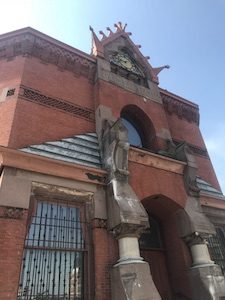
Furness’ building at Drexel: Paul Peck Alumni Center
The Drexel building, on the southeast corner of 32nd and Market streets, was originally built as the Centennial National Bank, an appropriate name, given that the nation’s Centennial celebration was held that same year, 1876, in Fairmount Park.
As phillyliving.com put it, “Furness capitalized on the building’s location at the main point from where fair-goers would arrive from Center City and head down Lancaster Avenue to the fairgrounds, now the western part of Fairmount Park. And there was no shortage of fair-goers—10 million people went, which is equivalent to 20 percent of the population of the United States today.”
Also still standing are the gates to the Philadelphia Zoo, the oldest zoo in the country, which opened its doors in 1874, just in time for the Centennial.

Furness Gates at the Philadelphia Zoo
One of the things I learned about Furness is how he combined an avant-garde use of steel, as in the boat bay of Undine, with a delight in nature. He loved using reds and greens in his buildings, the “colors of nature,” he called them. “Nature,” he wrote, “never makes a mistake in taste.”

Undine Barge Club, photo by Dotty Brown